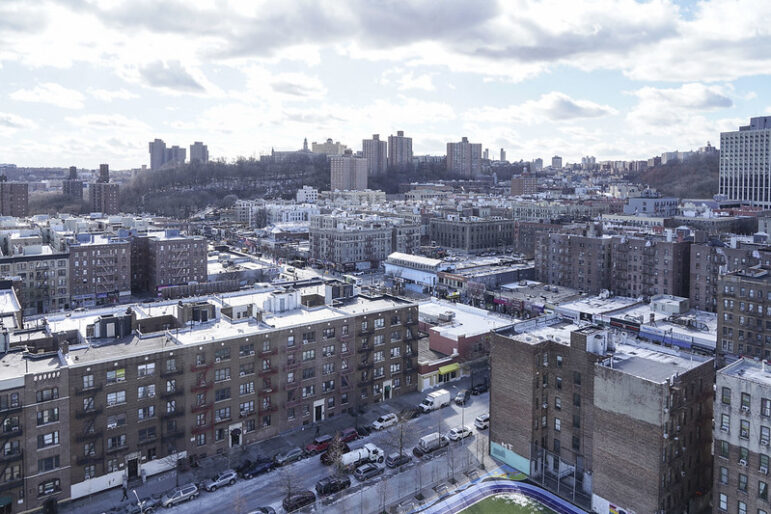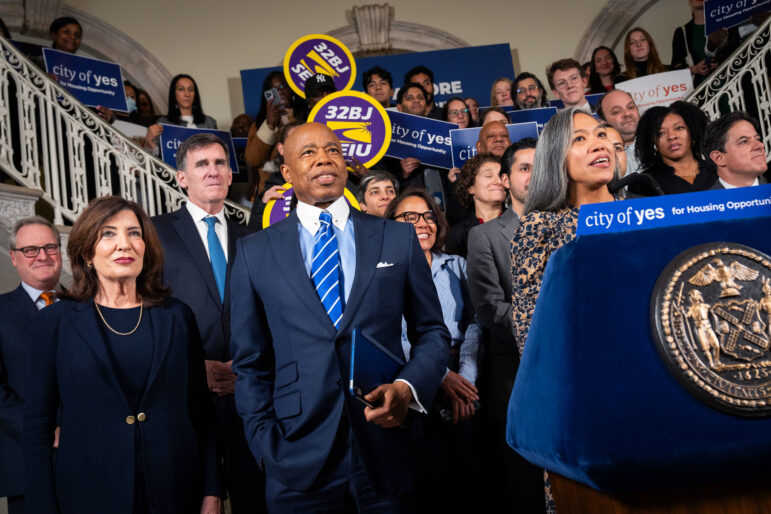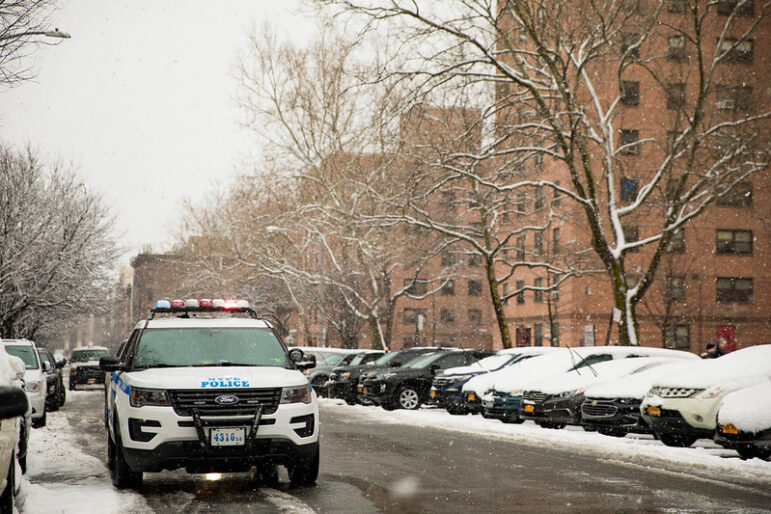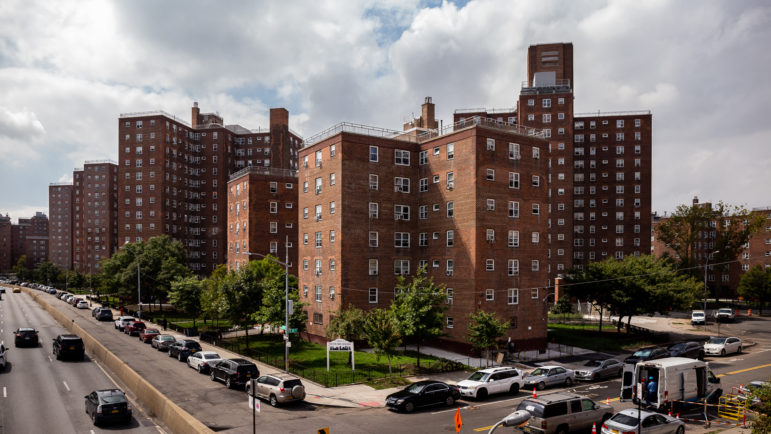Proposed changes to the zoning code would allow property owners in areas facing flood risks to take steps to protect their assets. But it would neither require nor fund such work.

Adi Talwar
Hunts Point’s eastern shore line at the mouth of the Bronx River.Eight years ago, the devastation of Superstorm Sandy set off a scramble to adapt the city’s development rule book to the growing threat of catastrophic coastal flooding.
That effort is likely to culminate next year with the adoption of new citywide zoning rules and local zoning changes in three vulnerable neighborhoods.
If the Department of City Planning’s Zoning for Coastal Resiliency proposal—which is now being reviewed by community boards—is approved by the City Planning Commission and the City Council, it will represent real progress toward making New York more resilient.
It will also leave much work to be done, according to advocates.
“It’s definitely a good step forward but it’s not a silver bullet,” says Cortney Worrall, the president and CEO of the Waterfront Alliance.
Rules for a wetter era
Four years before Tropical Storm Sandy killed 44 New York City residents and did $19 billion in physical and economic damage, the Bloomberg administration updated the city’s building code to require more resilient construction in the 100-year floodplain.
It became clear in the aftermath of the superstorm, however, that other city regulations made it hard for property owners to recover from storm damage or rebuild in a way that adhered to those updated resiliency standards. Having a backup generator in your yard or elevating your home above flood level, to cite two examples, could conflict with zoning rules.
The city adopted two waves of temporary zoning-law changes to work around those obstacles. Those measures will expire in the near future, however.
The current proposal would make them permanent. It would also tweak the rules based on the experience of the past eight years and input from more than 200 public sessions since 2016. Even the post-Sandy rules made it hard to install berms or store floodgates in a property’s open areas, for instance, but the new regulations will allow that.
The de Blasio administration’s proposal also expands the footprint of the resiliency measures. Right now, the zoning rules are relaxed only in the 100-year floodplain—the area where there is a 1 percent annual chance of flooding. That represents 15 percent of the city’s land mass, nearly 81,000 buildings, 436,000 residents and 15,000 businesses with 270,000 jobs.
Over time, however, the 100-year floodplain will grow, possibly to the size of today’s 500-year floodplain, where there is now only a 0.2 percent chance of flooding each year. Together, the two areas encompass 782,800 residents—more than the population of Seattle.
“Current building code standards that are tied to today’s storm surge projections may not be sufficient to protect buildings from being damaged by future storms,” the proposal reads.
For that reason, the policy would permit property owners in the broader 500-year floodplain to take advantage of the new zoning flexibility to make resiliency improvements, even if the building code does not require them to do so.
“I think overall it is very progressive,” Joel Scata, an attorney at the Natural Resources Defense Council, says of the city’s proposal. “It expands the vision of the flood plain. I think it recognizes that today’s depiction of the flood risk is not what it is going to be 30, 40 or 50 years from now.”
Flooding and finance
The zoning proposal appears to be a vitally important step for the city. “The land use regulation does help to solve the problem of ensuring that new development is done in a way that reduces instead of increases risk to people and their properties,” Worrall says. “And it really helps builders and designers and developers understand what they can do.”
What the proposed rules do not do is force anyone to make existing properties more resilient, or provide resources to help property owners take on the expensive work of rebuilding.
“If you’re not planning to raise your home or you can’t afford to do it or you’re not a builder planning to build new properties, this doesn’t help you,” Worrall says. “It’s not relevant … when the money isn’t there at the business level or the personal level to get this done.”
A combination of revised flood-insurance rules and updated flood maps from the federal government could create a strong financial incentive for property owners to do retrofits, so as to save money on insurance premiums. However, many property owners don’t have the upfront capital to make those moves. Elevating a single-family home can cost upwards of $100,000.
“For large-scale retrofits or elevations, which the zoning change makes easier by removing legal restrictions, they are going to be need to have grant money available as well, especially for low-income neighborhoods, because elevation can be exorbitantly expensive,” Scata says. “The flexibility in the plan really is beneficial and it should incentivize people to take resiliency steps but I think in lower-income neighborhoods there has to be the additional provision of grant funding.”
The de Blasio administration says the HomeFix program, a low-cost home-improvement loan program run by the Department of Housing Preservation and Development, could support some resiliency work—like the installation of backwater valves to prevent sewage backups—but would not cover full retrofits.
Another way to help property owners fund retrofits would be to let them borrow against the anticipated savings on flood insurance—an approach referred to as PACE (for “property assisted clean energy”) that has been applied to green-energy projects in much of the country, including New York State, and to resiliency work in nine other states. There have been legislative efforts to create a PACE for Resiliency program in the Empire State, but they has fallen short so far.
“Our multi-pronged adaptation strategy reflects the fact that there is no single silver bullet solution to the climate threats New York City faces. As we continue to build coastal protections and expand our green infrastructure, we’re also taking steps to enable building owners to invest in the resiliency of their private property,” Jainey Bavishi, director of the Mayor’s Office of Resiliency, said in a statement to City Limits.
“Zoning For Coastal Resiliency will give New Yorkers more flexibility to make retrofits while innovative new tools like PACE With Resiliency (PACER), can help provide low-cost financing to make these retrofits affordable.”
Advocates caution that PACE would have to be structured carefully to avoid layering new debt onto vulnerable property owners.
Seeking a more comprehensive strategy
“These regulations by no means serve to climate-proof New York City for the long term, but they do represent a critical and common-sense step forward for how we plan for flooding and disaster in at risk communities in the city,” says Robert Freudenberg, the Regional Plan Association’s vice president of energy and environmental programs.
“These regulations buy us some time,” he adds. “We have to make sure that we use that time productively and start having conversations about how we think about things like the fact that there might be places where we can’t build back or shouldn’t.”
The third rail of resiliency policy is the question of relocation, or what some people refer to as strategic retreat. “There are areas that will be inundated by sea-level rise and, before they are inundated, by repeated flooding,” Scata says. “The city needs an ongoing voluntary buyout program. Elevating properties is just a short term fix.”
The likely need to relocate some residents and businesses away from the water’s edge raises thorny issues of equity and self-determination. It also creates practical concerns, like how to make up within the city’s interior the lost residential density from its edges. Extreme coastal storm risk might be a problem that affects only a few neighborhoods, but its solution has to involve the entire map—and some thorough planning, ideally sooner rather than later.
“That comprehensive look needs to be done throughout the city,” Worrall says. The city’s current proposal, she says, “is an example of the limit of what zoning or other regulations,” can do.
Targeted neighborhoods
In addition to the citywide zoning changes, the de Blasio administration has proposed three neighborhood-specific sets of zoning revisions intended to address particular vulnerabilities in parts of the waterfront. Unlike the citywide proposal, two of those plans would also reduce buildable density in the future. In Gerritsen Beach and Old Howard Beach, the proposal would restrict development on small lots to single-family detached homes. Below-grade plazas would be banned in Sheepshead Bay.
Those three communities were part of a larger set of 10 “Resilient Neighborhoods” with special vulnerabilities that the city studied in the years after Sandy. Some of that research has informed the citywide resiliency zoning policy proposal, and elements of some studies worked their way into other local policy tweaks in Edgewater Park in the Bronx, Broad Channel in Queens and the East Shore of Staten Island*. It’s not clear if and when other rezoning proposals might be made, but movement on these three could cool criticism of the de Blasio administration for focusing resiliency planning on areas like Lower Manhattan, and not addressing imperiled parts of the outer-borough coastline.
Recommendations on all four proposals are due from community boards and borough presidents by Dec. 28. The spring likely will see final Council votes on these proposals, but certainly not a final chapter in the discussion over how to plan for the inevitable impacts of climate change.
“I think the benefit or the luxury we have is time. I think the hardest decisions, we won’t have to make immediately,” Freudenberg says. “I think the most important thing we can do now is have conversations with [vulnerable communities] about the long term. That’s easier said than done. Those are not easy conversations.”
*This paragraph was clarified to list the Resilient Neighborhoods where policy changes were previously made.









